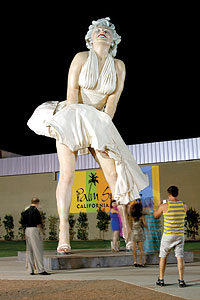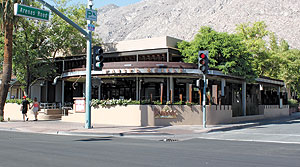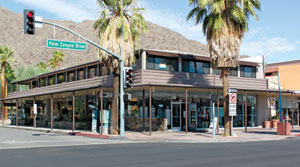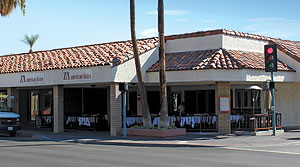
In the 1930s, Palm Springs became Hollywood’s back yard. Clark Gable and Carole Lombard, Spencer Tracy and Katherine Hepburn, Cary Grant, William Powell, Lana Turner, Ava Gardner, Marlene Dietrich, and many others came for the weather and privacy. This desert oasis remains a dream getaway, but it now also enjoys a vibrant full-time population, year-round businesses, and great variety of visitors. For years, with the closed Desert Fashion Plaza taking its toll on Palm Canyon Drive, they’ve been asking, “When will the city revitalize its downtown?”
An answer began to take shape in November 2011, when Palm Springs voters approved Measure J, a revenue initiative to finance land acquisition and public improvements with the first phase of the Downtown Revitalization Plan. The measure increased the local sales tax by 1 percent, which City Manager David Ready says is estimated to generate $280 million over the next 25 years. About $43 million is earmarked for the revitalization of Wessman Development’s Desert Fashion Plaza. Tourists reportedly will foot most of the bill.
“Our studies have shown that a majority of that tax is paid by visitors and tourists, although everyone pays sales tax,” Ready says. “But the majority of it comes from our tourism industry.”
 In celebration of what some consider a turning point, the city invited the public to the kickoff of the razing of the former Bank of America at Palm Canyon Drive and Tahquitz Canyon Way. A party atmosphere pervaded the Jan. 26 event with a radio station remote van blaring music, champagne, and the climatic moment when John Wessman chiseled away at the building from the seat of a Komatsu demolition tractor.
In celebration of what some consider a turning point, the city invited the public to the kickoff of the razing of the former Bank of America at Palm Canyon Drive and Tahquitz Canyon Way. A party atmosphere pervaded the Jan. 26 event with a radio station remote van blaring music, champagne, and the climatic moment when John Wessman chiseled away at the building from the seat of a Komatsu demolition tractor.
With the space cleared, a group of hoteliers joined forces to install Seward Johnson’s 26-foot statue of Marilyn Monroe — a temporary attraction to draw visitors to downtown businesses pending construction of a new plaza.
In June, the city’s Financing Authority, through De La Rosa & Co., offered for sale to the public $46 million of lease revenue bonds. They sold out within hours.
The effort to make over downtown Palm Springs began more than a decade ago and showed a measure of promise in 2002 when Wessman Development purchased Desert Fashion Plaza and submitted concepts between 2004 and 2007 to redevelop the site. A plan was approved in 2009, according to Michael Braun, Wessman’s senior vice president. But it wasn’t until 2011 that Wessman and the city agreed to a partnership to redevelop and revitalize the plaza. In August, Wessman was in the architectural design phase.
“We plan to demolish all buildings by summer 2013 and be under con-struction during the third quarter 2013,” Braun says. “All existing buildings will be demolished west of Palm Canyon [Drive].”
“Then [Wessman] is responsible for getting what is called the core and shell of the buildings done by the end of 2014,” says John Raymond, the city’s community development director. “Now, we’re reworking the plan so that [Wessman] can actually get tenants in at the same time — doing the tenants’ approvals while he’s [constructing] the buildings so that at the end of 2014 big parts of it are done, so that businesses are moving in and actually up and operating around December [2014] or January 2015.
“There will be some fashion retailers and some restaurants,” Raymond continues. “He’s hoping to get what’s called ‘chef-driven’ restaurants with celebrity chefs, things you see in Vegas or L.A.” Plans also call for other uses, including offices.
“The whole purpose of it is to really have a good mix of uses at the site, so it really creates a 24-hour environment,” Raymond says. “Whether it’s residential ultimately, whether it’s a hotel ultimately, whether it’s retail and a movie theater or whatever, what we want to do is — 24 hours a day — have people down there.”
Riff Markowitz, co-founder and managing director of The Fabulous Palm Springs Follies at the historic Plaza Theatre in the heart of downtown, welcomes more business, even in his own area of entertainment.
“As they say, ‘A rising tide lifts all boats,’ so we are optimistic for all downtown merchants, including the Follies,” he says. “Any sort of economic stimulus, especially for what could be the centerpiece of downtown, can only be good for all concerned.”
Early concepts of the revitalization plan met with opposition for including one of the city’s historically significant sites.
“Over the years, we have seen several plans proposed and later discarded. We have consistently objected to those plans that have included the unnecessary destruction of the historic Town & Country Center,” says Ron Marshall, president of the Palm Springs Preservation Foundation, referring to the international-style center designed by A. Quincy Jones and Paul R. Williams on the east side of Palm Canyon Drive. The current revitalization plan includes only the west side of Palm Canyon Drive. “In our opinion, there are no significant buildings in the Desert Fashion Plaza complex,” Marshall says.
The passage of Measure J called for the formation of an oversight commission tasked with recommending capital improvements for the portion of Measure J funding not set aside for replacing Desert Fashion Plaza. In August, the commission received a report allowing it to assign to projects roughly $600,000.
“The first and foremost project we are looking at is road improvements or street improvements,” says Aftab Dada, a commission member and general manager of Hilton Palm Springs. Other projects include improvements to parks, lighting, and fire safety.
“It’s exciting,” says Mayor Steve Pougnet. “The goals and purpose of Measure J are to support capital projects in the city — upgrading our parks, the library, the streets, and, of course, the downtown project. Measure J will deliver a new downtown and increased quality infrastructure. It will enhance the quality of life for Palm Springs residents.”
At the Crossroads
While residents, tourists, and downtown businesses await the transformation promised by Measure J, one junction in particular thrives: Palm Canyon Drive and Arenas Road.

Kaiser Grille opened on the southwest corner in 1998. With patio seating along both streets, the restaurant makes a highly visible presence. Last fall, Kaiser Restaurant Group performed an extensive renovation and energized the front of the restaurant by giving the bar (now three sided) center stage. Owner Lee Morcus stands behind Measure J.
“I’m not one for more taxes. I’m a fiscally conservative guy,” he says. “But I think it was the right thing for the city to do.”
Palm Springs General Store got a fresh makeover and more room for retail by moving down the street into a former art gallery space on the northwest corner.

New to the city, Stark + Kent opened a contemporary art gallery in May one address north of the northeast corner proper.
“We have been blown away by the number of visitors not only from California cities and surrounding states, but also from Canada and Europe,” says gallery owner Mike Soltis. “We certainly didn’t expect to be shipping pieces to Paris and Germany this early in the game. Because there is such a focus in Palm Springs on the arts and design, we are incredibly grateful to the city and other business owners who have been so supportive of us and our artists.” The gallery celebrates with a grand opening reception at 4 p.m. on Oct. 27.

One door down, Zin American Bistro literally took its business outside. Previously, bistro customers could dine at tables by open windows. In 2011, owner Mindy Reed tore down walls and the ceiling and expanded her frontage with a sidewalk patio.

Lulu California Bistro on the southeast corner became a bright spot for downtown when it opened last year. After renovating the building that previously housed an art gallery and then three nightclubs, Lulu owners Jerry and Barbara Keller prove there’s validity in the concept of “Build it and they will come.”
— Janice Kleinschmidt